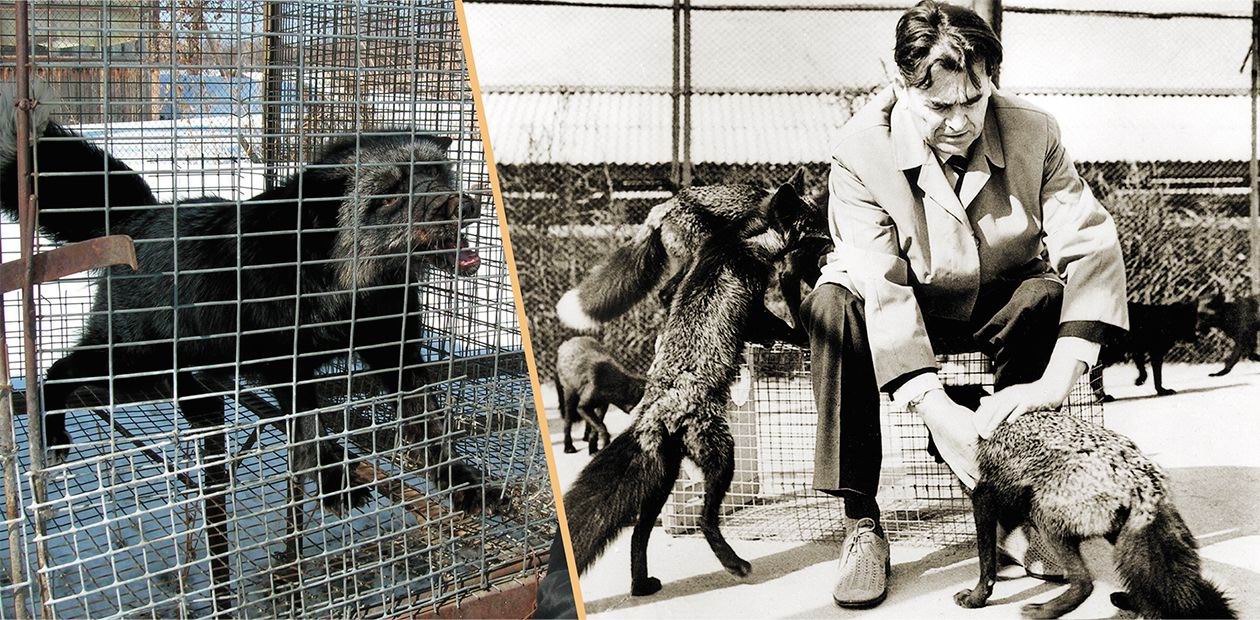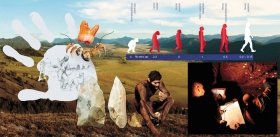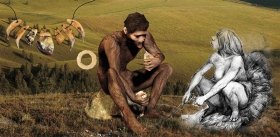An Evolutionary Experiment
The name of academician D. K. Belyaev is connected, first and foremost, with the research into the main biological process, evolution. The scientist opened a completely new, previously unknown to geneticists, chapter of the theory of morphogenetic processes related to the interaction between the main factors of evolution — variation and selection — and used the method quite unusual for such studies, experiment
Domestication of animals is a specific evolutionary event. The debates about the scope and rate of domestication-related changes, which are unexplainable from the standpoint of genetic theory, have been continuing since the time of C. Darwin. It seemed reasonable to trace experimentally the evolutionary pathway of animals subject to domestication during selection according to behavior.
This large-scale experiment reproducing the earliest stage of domestication was commenced by Belyaev as long ago as in the early 1950s with silver-black foxes. The essence of this experiment was the selection of foxes for the tolerance to humans. As a result, a unique population of domesticated foxes, known worldwide, was created. Moreover, the experiment is being continued.
From Foxes to Dogs
The results of an unusual evolutionary experiment have demonstrated that the genetic transformation of behavior (from wild to domesticated) entails the morphological and physiological changes similar to those that took place in the past in dogs and other domestic animals. Of the physiological changes, note first an increase in the activity of the most important vital function, reproduction, and weakening of the functional state of the hormonal system underlying adaptation and stress, the pituitary — adrenal system. In other words, the selection according to behavior pattern disrupts the physiological and morphological systems created and maintained in nature by stabilizing selection. The theory of stabilizing selection was created by I. I. Schmalhausen.
A similar character of the changes in animals under domestication as well as the fact that they occur quickly is hardly explainable from the standpoint of trivial genetic mechanisms. Why do the animals involved in the domestication process whose evolutionary routes never crossed before start evolving in the same way? This suggests that there exists a universal genetic mechanism of morphogenesis at the very first stage of domestication and that the selection at this stage in any animals acts on certain regulatory loci specific for domestication.
Based on these facts, prof. Belyaev formulated a principally new concept of naturally present destabilizing selection as a specific form of directional selection, which results in destabilization of the regulatory systems of ontogenesis (individual development) and, as a consequence, a drastic increase in the rate of morphogenesis.
D. K. BELYAEV, outstanding evolutionary geneticist, member of the USSR Academy of Sciences, Director of the Institute of Cytology and Genetics (1959—1985)
Domestication is similar to a cataclysm. During domestication, an explosion of morphogenetic process and its redirection to new pathways take place due to the loosening of the homeostatic systems created by the previous evolution, and deeply concealed forms of genetic material (dormant genes) get from the mobilization reserve.
<…>The experiment with domestication allows an insight into the potentialities of a species. If necessary, science is able to realize any such potential: after all, according to N. I. Vavilov’s definition, breeding is the evolution controlled by human will.
<…>Is it possible that the secret of changes has been irretrievably lost in the centuries and millenniums? Is it impossible to reproduce the great biological experiment adjusting it to the human lifespan? It has turned out possible*.
*Belyaev, D.K. and Trut, L. N. From natural to artificial selection: The miracles of breeding //Science in the USSR, 1982, no. 5.
The stabilizing function of selection is substituted with the destabilizing one because the specific “pressure” of behavioral selection focuses on the neuroendocrine system, which is the key system regulating the course of the entire ontogenesis. This explains a drastic increase in the rate of morphogenesis under extreme ambient conditions, in particular, captivity. The variation in captivity occurs due to the disruption of stabilized development systems, which can result in activation and phenotypic manifestation of previously inactive genes.
D. K. Belyaev’s idea on the role of functional activity of genes in the evolution of changes at that time was hypothetical and confirmed only by the data on abnormalities in the inheritance of several mutations involved in the control of pelage pigmentation pattern. As for now, the phenomenon of genetic silencing is recognized by all scientists. In particular, certain experimental data indicate that the human evolution was accompanied by changes in the functional activity of some genes.
1960. Commencement of a unique experiment on domestication of silver-black foxes
D. K. Belyaev’s hypothesis about destabilizing selection was highly commended by his foreign colleagues. “It is not easy for a biologist to assess the processes of evolution that took place in the past. However, one experiment with artificial selection can reconstruct an effective picture of events that occurred in nature. One outstanding experiment of this type was actually conducted with foxes… Indeed, this large-scale and original experiment can be regarded as one of the most intriguing experiments of the century directed to systematic research into the nature of evolutionary processes” (Coppinger, Feinstein, 1991).
And this is the opinion of US geneticist G. Lark, expressed in 2003: “It becomes ever clear to me that the experiment with foxes is one of the actually grandest experiments over several last decades. As if you in Novosibirsk knew beforehand what would be needed in future for the integrative genetics of quantitative traits. Doubtlessly, Belyaev was a great personality”.
“Domestication” of Man
Anthropogenesis and domestication are frequently compared. But how can be related the evolutionary transformations of, for example, dog and man, the acme in the evolution of life on the Earth? In 2003, an outstanding evolutionary anthropologist R. Wrangham wrote in a letter addressed to L. N. Trut: “Our present concepts of the human evolution are most greatly influenced by your work on domestication of foxes”.
As is well known, the most significant stages in the evolution of the family of men, Hominidae, took place in Africa about five to six million years ago; as a result, the branches of humans and chimpanzees separated from the common ancestor. A comparison of contemporary African monkeys and archaeological data suggest that the chimpanzoid phenotype, which still exists in chimpanzee, is an appropriate candidate for the ancestor phenotype. Here it is important that R. Wrangham regards bonobo, or pygmy chimpanzee, as a possible prototype of the progenitor of humans.
Bonobo is amazingly close to Australopithecus, our most ancient ancestor. Which factors made this prototype diverge from the common chimpanzoid ancestor, evolve, and become the forefather of the family Hominidae? This is where the correlation between the data of US anthropologists and those of our experiment becomes evident. The fact is that the differences between chimpanzee and bonobo are virtually identical to those between domesticated and wild foxes. First and foremost, bonobo evolves in a more “friendly” way, allowing this anthropoid ape to be regarded as a tame chimpanzee. It is assumed that the earliest bonobo ancestors could find themselves under ecological conditions directed strongly against aggression within the group towards peaceableness and cooperation.
Scientists believe that this selection could have produced the set of physiological and morphophysiological changes discovered in bonobos similar to that of tamed foxes. In February 2007, the US scientist wrote: “Since Darwin called attention to the mysteries of correlated alterations in domesticated animals, science had been waiting for explanations. The brilliant experiment of Dmitry Belyaev opened the door for resolving this problem. His work is a breakthrough to a new route important for evolutionary anthropology not only as an amendment to unexplained adaptations, but also because the specific behavioral traits influenced by natural selection are related to the human evolution. Since the emergence of Homo sapiens, sexual dimorphism, the sizes of visceral cranium and teeth, and thickness of limb bones were decreasing similar to those of domesticated animals”.
Belyaev himself characterized this process as follows: “We know well that hormones realize their regulatory function through the alteration of gene functional activities and that this regulation can be of a cascade character. Consequently, a change in the central system of neurohormonal regulation that took place during the evolution of man, automatically entailed a drastic change, i. e., destabilization of the traits and functions stabilized during the previous evolution. In this sense, the selection according to the features and functions of brain during the human evolution created a similarly wide variation and accelerated the rate of morphogenesis just as during the domestication of animals”.
L. N. Trut, doctor of biology (Institute of Cytology and Genetics, SB RAS, Novosibirsk Scientific Center)














